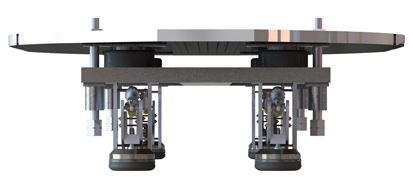Imagine zooming between cities in a high-speed transportation pod at 700-plus miles an hour, all the while levitated above a small pocket of air.
Pod_1.0
Shown above is the version of the passenger pod that the Drexel team submitted to the initial Design Weekend contest. On the basis of this design, the team was asked to continue in the contest and create a prototype with some modifications and improvements. The latest incarnation of their design, which is lighter and easier to manufacturer, is below.
Now imagine designing, engineering, manufacturing and marketing a prototype of that very pod, all from scratch and while still an undergraduate student, with a chance to have your design incorporated into a new mode of super-fast transit envisioned by SpaceX founder and inventor Elon Musk.
For about 70 students at Drexel University, it’s all real. They are one of 31 college teams, out of 1,200 original contestants from around the world, who have been chosen to advance in Musk’s 2016 SpaceX Hyperloop Pod Competition after presenting their initial design to Musk, academics and other judges in January.
At press-time, the Drexel Hyperloop team is putting the finishing touches on its ambitious concept — a prototype of the bullet-like capsule that would hold passengers in Musk’s visionary transit system.
“This is not just a project you do in school,” says Om Mahida, 22, a junior computer engineering student who’s involved in software development for the pod’s control system. “You’re basically running your own startup.”

TECH_SUPPORT
The Drexel team has rallied companies to its cause. Among the sponsors are ide Group, a product design and development company with offices outside Philadelphia and in Sydney; Exelon Generation, a power generator serving the Midwest, Mid-Atlantic, Texas and California; and M2VP, a technology strategy consulting firm from West Chester, Pennsylvania. New Way Air Bearings, an air bearing manufacturer in nearby Chester, Pennsylvania, is working with the team to make the hoover pads will that allow the pod to float along the rails at super-fast speeds.
Most teams are focusing on a subsystem, but the Drexel Hyperloop team is among the few that decided to take on the whole shebang, down to a design for a pod transit station.
_gliding on air
The round hockey-puck-like nodes at the bottom of the dynamic floor are an air bearing system that is unique to the Drexel team’s design. Pressurized air tanks on board the pod direct streams of air downward from these bearings, which puts a small pocket of air between the pod and the track. The air bearings allow the pod to basically levitate over the track without friction. The concept is similar to hydroplaning, when a thin layer of water separates a vehicle’s tires from direct contact with the surface of the road.
Those teams that have made the cut — meaning they secured tech company sponsors to build prototypes that can cost upwards of $70,000 — will test their designs in Hawthorne, California, on a mile-long Hyperloop, which is the near-vacuum transportation tube that Musk proposed in 2013.
The concept works like a puck on an air-hockey table: Pods for either passengers or cargo float on a very thin air cushion to minimize the friction, the main culprit that limits speed, and as a result attain miles per hour, at least theoretically, close to Mach 1. A six-hour car ride between Los Angeles and San Francisco would be a mere 30 minutes on a Hyperloop.

Bullet_Train
The final prototype being finished by the Drexel team is designed to be easy to manufacture while remaining lightweight and aerodynamic.


